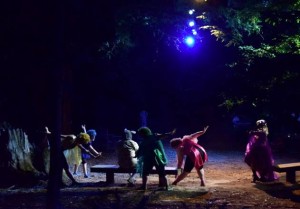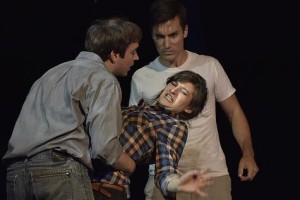Never Anything Can Be Amiss: A Review of A MIDSUMMER NIGHT’S DREAM at Portola Valley Theatre Conservatory
August 2, 2015 § Leave a Comment
In their current offering, The Portola Valley Theatre Conservatory creates a conceptually-exciting, immersive staging that engaging explores the contrast between the soul-crushing city and the wild forest at the thematic heart of A Midsummer Night’s Dream.
Portola Valley is a rustic coastal California town, so bucolic that it is hard to believe it is only a half-hour south of bustling San Francisco, and within easy hiking distance of Stanford University. Tucked in between two large land preserves, it is a small dot of civilization placed amidst the giant redwoods. PVTC utilizes this arrangement in its site-specific setting to the fullest.
Site-specific and Immersive
The concept is initiated when one’s reservation is confirmed with a charming (and very contemporary) e-mail in the form of an invitation to Duke Theseus’ upcoming wedding. Along with the ubiquitous engagement photo, it gives the time and place, with a suggestion that the dress code is “layers” and guests might want to bring insect repellent.
Arriving at the site, which turns out to be a local protestant church, one is greeted at the edge of the parking lot by wedding ushers who – completely in character – apologize profusely that things are not quite ready for the ceremony, and in a disturbingly realistic scenario, ask the small audience to cool its heels outside while last-minute arrangements are completed.
When we are finally herded inside, we are led first to a small set representing the office of a wedding planner complete with piles of bridal magazines, catering menus and other commercial paraphernalia that overburdens modern weddings. The contemporary tone is reinforced by Hippolyta (Sarah Benjamin), who wears a t-shirt with a variation on a familiar meme that says, “I can’t keep calm and carry on, I am the bride.” The audience shares the space with the actors, standing around the edges or just sitting down on the floor to watch Egeus intrusively demand that the distracted Duke (Bryce Chaddick) force his daughter, Hermia, (Lydia Cuffman) – against her will – to marry Demetrius (William J. Brown III), instantly identifiable as a hipster because he is wearing his fashionable sunglasses inside.
Take a Hike
After the first scene plays out, we are urged to follow Hermia and her beloved, Lysander (Matt Waters), into the woods where they are fleeing in hiking gear – complete with backpacks and sleeping bags. They are tailed by Demetrius’ ex, Helena (Alanna McNaughton) and by Demetrius, himself. While heading out toward a redwood grove, we encounter the rude mechanicals preparing their play in a courtyard, and pass a strategically placed fairy queen (Cheryl Goodman-Morris) preening over a changeling boy (John Max Byrne).
The second and third acts of the play are staged in the midst of a towering redwood grove, which is directly referenced in the performance in a clever substitution for Shakespeare’s hawthorn brake. (In a similar textual alternation, they will discover in the almanac that not only does the moon shine when they need it, but that it will be the Blue Moon that actually graced the performance.) Although conveniently lit with theatrical instruments and accompanied by Shane Turner’s live score, it is still the dust, stones, sticks and pine scent in the clearing where we gather that make the long night in the woods tactile and immediate. Kevin Gibbs is credited with the “Aesthetic Design.” Even when “off-stage,” fairies hover in the shadows and the sound of the living forest is always present. The scene seems literally enchanting.
My favorite piece of staging happenes on the trip back from the woods, when we observe Bottom’s friends anxiously scouting the horizon for any sign of him – all sitting on the parish hall rooftop. Talk about site-specific! Later we are led back inside to an interpolated, but nicely moving, triple wedding in the chapel, featuring a beautiful tenor solo by Don Gustafson (who also plays Egeus.)
From there we finish our evening on a candlelit patio, drinking champagne and munching petit-fours while (along with the Duke and his party) we enjoy the heartfelt entertainment presented by the rustics. (Ashley Pogue, Andrew Saier, Mark Goodman-Morris, Angela Khalipa, and John Kissel make up this motley crew, along with Andrew P. Quick in the always scene-stealing role of Flute/Thisbe.)
I’m Feeling It
By far the most interesting part of the evening was director Noëlle GM Gibbs’ immersive staging, perfectly fitted to the play. Her conceptual aim sometimes exceeded the grasp of her largely amateur cast, but the aim was, nonetheless, always true. Is there any place that better represents the unromantic excesses of social conformity than a wedding planner’s salon? Conversely, can there be any better way to realize the mystic power of nature than to take us – even a little way – out into the forest? (What was that sound, anyway, and what did I just step on?)
Having seen Midsummer dozens of times, I cannot recall having ever experienced the woods so powerfully. The visceral power of immersive staging, however forced it may initially seem, can transform an ordinary performance into a fully absorbing aesthetic experience as you begin to feel yourself part of the action and the environment becomes a character in the drama.
Unsurprisingly, the Equity guest artist William J. Brown III, as Demetrius, gives the best performance of the evening. (Brown is the Artistic Director of the Arabian Shakespeare Festival, and an actor whose work I have previously admired.) Matt Waters as Lysander and Bryce Chadwick as Theseus also give especially compelling performances.
This production gives unusual prominence to the lovers, and their journey of self-discovery over the course of the night is treated without condescension. They are funny, but more than farcical. The inability to know who we are when overburdened by the demands of civilization, and the liberation of finding our natural selves, emerge as serious themes for once. (Brown’s terrific moment of conversion upon waking from his night in the woods and realizing that he really does love Helena is about as good as acting gets.)
The evening was certainly not without its deficits. The scansion was something of a disaster throughout, and the fairies were garishly costumed Victorian conceptions surprisingly out-of-keeping with natural woods in which they were located. If ever wildly folkloric, instead of tame balletic, fairies were called for, this was the time!
Still, given a play that so thoroughly praises and celebrates the effective sincerity of amateur actors who are giving it their best shot, it would be churlish to deny their winning charm in this case. (I’ve certainly witnessed many fully professional productions that were both less interesting in their ideas and less engaging in their presentation.) Life and art converge in the final scene, where both the characters and their real-life interpreters rise to the occasion when the moment calls for it, and the effect is deeply moving. This is Shakespeare’s love-letter to the theatre, and PVTC’s innovative production makes us see it – no, experience it – freshly and intensively.
A Midsummer Night’s Dream
Portola Valley Theatre Conservatory
July 30 – August 2, 2015
Seen (under the Blue Moon) on July 31



Leave a Reply